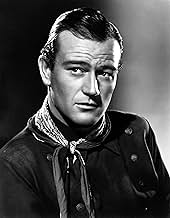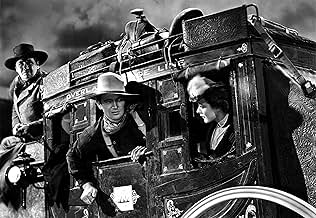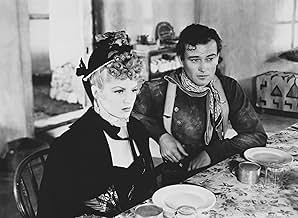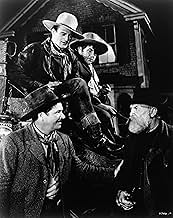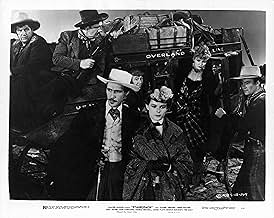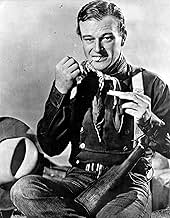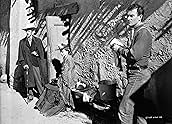A group of people traveling on a stagecoach find their journey complicated by the threat of Geronimo and learn something about each other in the process.A group of people traveling on a stagecoach find their journey complicated by the threat of Geronimo and learn something about each other in the process.A group of people traveling on a stagecoach find their journey complicated by the threat of Geronimo and learn something about each other in the process.
- Won 2 Oscars
- 7 wins & 5 nominations total
- Girl in Saloon
- (uncredited)
- Indian Scout
- (uncredited)
- Bit Part
- (uncredited)
- Bit Part
- (uncredited)
- Lordsburg Saloon Owner
- (uncredited)
- Director
- Writers
- All cast & crew
- Production, box office & more at IMDbPro
Storyline
Did you know
- TriviaYakima Canutt explained how the stunt was accomplished where, as an Apache warrior attacking the stagecoach, he is "shot", falls off his horse, and then gets dragged underneath the stagecoach: "You have to run the horses fast, so they'll run straight. If they run slow, they move around a lot. When you turn loose to go under the coach, you've got to bring your arms over your chest and stomach. You've got to hold your elbows close to your body, or that front axle will knock them off." After the stunt was completed, Canutt ran to director John Ford to make sure they got the stunt on film. Ford replied that even if they hadn't, "I'll never shoot that again."
- GoofsAfter arriving at the second stop on the journey, the sheriff refers to the army, calling them "calvary" instead of "cavalry". This is not only a common mistake by uneducated actors, but may be the most often repeated mispronunciation in the history of movie westerns.
- Quotes
Marshal Curly Wilcox: Come busting in here - you'd think we were being attacked! You can find another wife.
Chris: Sure I can find another wife. But she take my rifle and my horse. Oh, I'll never sell her. I love her so much. I beat her with a whip and she never get tired.
Dr. Josiah Boone: Your wife?
Chris: No, my horse. I can find another wife easy, yes, but not a horse like that!
- Alternate versionsAlso available in a computer-colorized version.
- ConnectionsEdited into Laramie (1949)
- SoundtracksTrail to Mexico (Bury Me Not on the Lone Prairie)
(uncredited)
Traditional ballad
Variations played throughout as part of the score
The Ringo Kid has been wrongly accused of a crime and is on his way to Lordsburg to avenge both the false accusations and more importantly, the murder of his father and brother. Dallas (Claire Trevor) is implied to be a prostitute, and so is ostracized from Tonto (which means "stupid", "foolish" or "daft" in Spanish) by a self-stylized matronly moral majority. Doc Boone (Thomas Mitchell) is far more concerned with getting drunk than being a doctor, and is partially ostracizing himself from Tonto. Hatfield (John Carradine) is a "gambler gentleman" with a shady reputation and a false identity. Lucy Mallory (Louise Platt) is trying to get to her husband, who is in the military; she's in a surprisingly "secret" physical state. Samuel Peacock, whom everyone keeps mistaking for a reverend, is in the alcohol business and just wants to get back east to get back to his business. Henry Gatewood is a crooked banker trying to flee before his questionable dealings are discovered. And the stagecoach drivers consist of a lovable buffoon, Buck (Andy Devine) and the most forthright, straight arrow of the bunch, Marshal Curly Wilcox (George Bancroft).
Even though Stagecoach remains tightly focused on its wilderness road trip, that might seem like a large stable of characters to shape into a taut plot. Ford, working from script by Dudley Nichols and Ben Hecht, based on a short story, "Stage to Lordsburg", by Ernest Haycox (which itself bears a relation to Guy de Maupassant's "Boule de Suif", 1880), keeps the proceedings in check by only giving us the information we need to explore the evolving relationships, and only focusing on each character when they're important to the plot. This results in a few of the characters being functionally absent for extended lengths of time, but Ford can so easily establish a "deep" character with a minimum of screen time that the absences are not a detriment.
The principal focus, of course, is between Ringo and Dallas, as on a significant level, Stagecoach becomes a romance. They're initially brought together via their mutual ostracization, even among the ostracized, which gives them an immediate bond beyond their physical attraction towards one another. Wayne and Trevor are both fantastic in their roles, avoiding the occasional overacting by some other performers. But this is a film where it's difficult to count the slight overacting as a flaw, as it was more of a stylistic tendency of the genre during this period and it provides a nice counterbalance to Wayne and Trevor.
Stagecoach is also famous for its setting. Much of the film was shot in Utah's Monument Valley, along authentic stagecoach "roads". The (beautiful) starkness of the desert is often taken as a symbolic trip through a kind of purgatory for the characters, where they're left alone with their souls, their only connection being their small group, to contemplate their pasts and futures. Whether we choose to read something along those lines into the film or not, Monument Valley is at least a captivating presence in the film, although for me, the cinematography could have been better technically, especially considering that Stagecoach was made at the same time as The Wizard of Oz (1939). Ford's famous tendency to do only one take results in a couple minor gaffes, such as the initial shot of John Wayne--a zoom into a close-up--that is out of focus for most of the zoom.
As one could guess, eventually our passengers run into a band of Apaches, who are often interpreted as representing more of a "natural force" that our heroes must surmount. The climax features a fabulous extended chase/fight sequence with a number of amazing stunts by both humans and animals. The most impressive human stunts are performed by the legendary Yakima Canutt, including one that involved being dragged through the dirt by the horse-pulled stagecoach, which was moving along at about 40 miles per hour and supposedly missed running over Canutt by only 12 inches (30.5 cm). This scene was an inspiration for a similar stunt in Steven Spielberg's Raiders of the Lost Ark (1981).
Although it's not a "perfect" film to me, and it's not even my favorite western (I'm more partial to the classic spaghetti westerns, for example), Stagecoach is a very good film and was very influential, despite being made at a time when Ford was told that he was committing professional suicide by even contemplating a western. As the plethora of critical literature attests, it works on many levels, including as an allegorical microcosm of U.S. Depression-era society, and should be seen at least once by anyone serious about film literacy.
- BrandtSponseller
- Apr 29, 2005
- Permalink
- How long is Stagecoach?Powered by Alexa
Details
- Release date
- Country of origin
- Languages
- Also known as
- Stagecoach to Lordsburg
- Filming locations
- Agathla Peak, Arizona, USA(Peak in background at start of stagecoach trip)
- Production company
- See more company credits at IMDbPro
Box office
- Budget
- $392,000 (estimated)
- Runtime1 hour 36 minutes
- Color
- Aspect ratio
- 1.37 : 1
Contribute to this page




